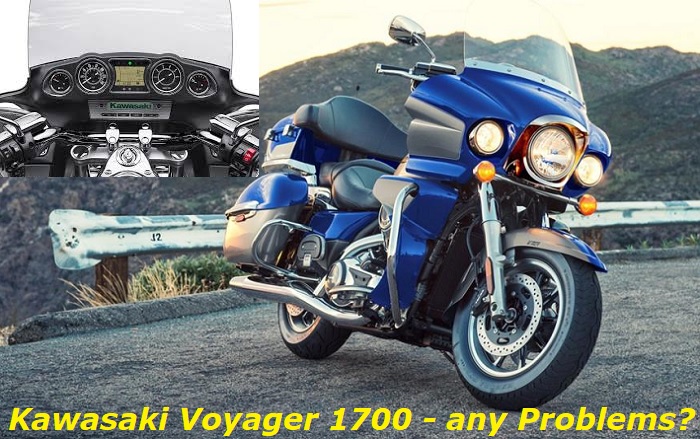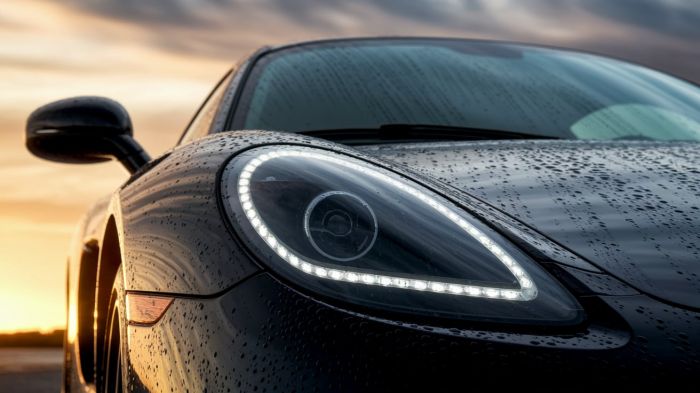The Kawasaki Vulcan 1700 series is known for its Vaquero and Voyager trims. Both of which present a nice entry point for those who want to get into touring motorcycles. The Voyager is the crème de la crème of the Vulcan if you want to get the most out of it.
Overall, the Kawasaki Voyager 1700 enjoys a good rating from owners. However, there have also been some complaints about the model mostly about its performance. In this article, we will take a look at the common issues that the majority of the cruiser's owners have to deal with as well as ways to diagnose the source of the problem and the possible solutions for each cause so you will at least have an idea how to deal with them.

Most Common Problems Encountered by Kawasaki Voyager 1700 Owners
We will cover here the key complaints of Kawasaki Voyager 1700 owners, which include the following:
- Low stock power
- Engine bogging
- Shorted ignition wiring
Problem Number 1: Low Stock Power
Most complaints stem from the allegedly lower-than-expected output of the motorcycle. This is not a problem per se but more of an issue based on most users' preferences.
It should be noted that the 2022 Vulcan 1700 Voyager houses a liquid-cooled, four-stroke, 52-degree V-twin engine. The unit sports a displacement of 1,700cc with a bore of 102 mm, a stroke of 104 mm, and a compression ratio of 9.5:1. The fuel delivery of the big bike is managed by a ducted fuel injection (DFI) system and its drivetrain utilizes a carbon fiber belt. Moreover, it is highlighted by its electronic cruise control and Kawasaki's Advanced Coactive-Braking Technology (K-ACT II) ABS.
The max torque of the Voyager 1700 is pegged at 107.6 lb-ft of torque distributed via a six-speed transmission. There's no mention from Kawasaki about its horsepower output but it is estimated to be at 73 hp. On paper, these make a decent figure but there are a number of owners who think that there's plenty of room for improvement in this area.
- Solutions
If you're looking to extract more power from your 2022 Vulcan 1700 Voyager ABS, there are a few different ways to go about it. One option is to have the ECU (engine control unit) flashed. This can provide a noticeable power boost, particularly if the bike is stock. Other ways of boosting power include adding an aftermarket exhaust or air intake or tweaking the engine settings themselves.
Of course, different mods will result in different power gains. Generally speaking, though, you can expect around a 10% increase in power with some simple bolt-on mods. If you go all out with an ECU flash and other more involved mods, you could see gains of up to 20%.
Although the aforementioned methods definitely come with plenty of benefits to your motorcycle in terms of performance, do note that these can be considered very intrusive processes coupled with risks if not done properly. As a result, you may void your warranty along the way and you may expose your bike to quick premature wear, especially its engine components. Therefore, tread carefully when it comes to tuning it and do employ the aid of a qualified mechanic in this undertaking.
Problem Number 2: Engine Bogging
Bogging is when an engine is having trouble getting enough air. This can be caused by several things, including a dirty air filter, a clogged fuel injector, or a faulty spark plug. When your engine is bogging, it will usually make your Voyager 1700 run rough and may even stall.
- Solutions
As this problem can be triggered by a variety of issues, here are ways to address the possible causes:
a. Cleaning or Replacing the Air Filter
One of the most important maintenance tasks of the Voyager 1700 involves replacing or cleaning its air filter. Luckily, this is a relatively simple task that can be done at home with just a few tools if you want to save yourself a trip to your mechanic. Here's how to access and clean or replace the air filter on your Kawasaki Vulcan 1700 Voyager:
- First, locate the air filter cover on the left side of the engine. Remove the bolts holding it in place.
- Once the cover is open, you'll see the air filter element. Pull it out and inspect it. If it's excessively dirty, you'll need to replace it. Otherwise, you can clean it with a brush or compressed air.
- To reassemble, simply reverse the process. Insert the clean or new air filter element into the housing and close the cover. Make sure the bolts are properly tightened to complete the process.
b. Replacing the Fuel Injector
Worn fuel injectors impede the proper delivery of fuel to your engine. Always ensure that they are clean and working perfectly.
Here's how to locate and clean or replace them if such a need arises:
- Locate the fuel injector on the Kawasaki Vulcan 1700 Voyager. The fuel injector is located under the left side cover, just forward of the battery compartment. You may have to remove the seat and fuel tank of the motorcycle to access it conveniently.
- Disconnect the negative (-) part of the battery to avoid electrocution.
- Unscrew the two retaining screws that secure the fuel injector to the side cover using a Phillips head screwdriver.
- Pull the fuel injector out of the side cover.
- Carefully wipe off any soot that you may encounter.
- Inspect the O-ring seals on the fuel injector for damage or deterioration. If necessary, replace the O-rings with new ones.
- Insert the cleaned or new fuel injector into the side cover and bolt in the retaining screws securely.
- Reconnect the negative (-) battery terminal.
- Secure the fuel tank and seat properly by bolting them in place.
- Start the engine and check for leaks, which may indicate the improper installation of your engine components.
c. Cleaning or Replacing the Spark Plug
A problematic spark plug can obstruct the proper delivery of power to fire up your engine. Thus, if it's either dirty or worn, it can bog your power unit. Cleaning or replacing the spark plug is easy, and can be performed using the following steps:
- Find the location of the spark plug on your Kawasaki Vulcan 1700 Voyager. The spark plug is located on the side of the engine, near the bottom.
- Disconnect the spark plug wire from the spark plug.
- Use a spark plug wrench to loosen and remove the spark plug from the engine.
- Inspect the spark plug for deposits or damage. If necessary, clean the spark plug with a wire brush or replace it with a new one.
- Reinstall the spark plug in the engine and tighten it with the spark plug wrench.
- Reconnect the spark plug wire to the spark plug.
- Start the engine to ensure the proper operation of your cruiser.
Problem Number 3: Shorted Ignition Wiring
In 2015, Kawasaki ordered a recall of the 2009 to 2015 models of the Vulcan 1700 Voyager due to various electrical issues. According to the announcement of the company at that time, the ignition wire of the motorcycle has the tendency to rub on the fuel tank. As a result, it is prone to short circuits, which can also lead to engine stalling. If left, unchecked it could cause fires, too.
- Solution
Kawasaki offered to fix the affected models during the said recall. However, if you missed the boat and you are experiencing the problem just now, here is your chance to fix it using the following steps:
- Park your Kawasaki Vulcan 1700 Voyager and turn off the engine.
- Disconnect the negative (-) battery cable from the battery terminal using a wrench.
- Remove the left side panel of the fairing by loosening the screws with a Phillips head screwdriver.
- Unscrew the seat bolts with a wrench and remove the seat to access the ignition wiring.
- Disconnect the Ignition coil connector (green) from the Ignition coil (black).
- Remove the two 10mm bolts that secure the Ignition switch assembly to the frame using a socket wrench and disconnect the Ignition switch connector (white).
- Take out the old Ignition switch assembly from the frame.
- Install the new Ignition switch assembly in the frame and secure it with the two 10mm bolts.
- Reconnect the Ignition switch connector (white) to the new Ignition switch assembly.
- Reattach the Ignition coil connector (green) to the Ignition coil (black).
- If the issue has affected the other wirings, do replace them as well.
- Put the seat back on and screw in the seat bolts with a wrench.
- Replace the left side panel of the fairing and tighten the screws with a Phillips head screwdriver.
- Reconnect the negative (-) battery cable to the battery terminal using a wrench and start your engine. Your new ignition wiring is now installed!
Conclusion
The Kawasaki Vulcan 1700 Voyager is a powerful and stylish motorcycle that turns heads wherever it goes. But like all others, it needs regular maintenance to keep it running smoothly, and that includes addressing its common problems immediately as they occur.
About the authors
The CarAraC research team is composed of seasoned auto mechanics and automotive industry professionals, including individuals with advanced degrees and certifications in their field. Our team members boast prestigious credentials, reflecting their extensive knowledge and skills. These qualifications include: IMI: Institute of the Motor Industry, ASE-Certified Master Automobile Technicians; Coventry University, Graduate of MA in Automotive Journalism; Politecnico di Torino, Italy, MS Automotive Engineering; Ss. Cyril and Methodius University in Skopje, Mechanical University in Skopje; TOC Automotive College; DHA Suffa University, Department of Mechanical Engineering






Add comment